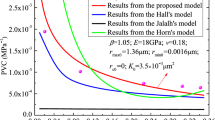Abstract
Many natural porous geological rock formations, as well as engineered porous structures, have fractal properties, i.e., they are self-similar over several length scales. While there have been many experimental and theoretical studies on how to quantify a fractal porous medium and on how to determine its fractal dimension, the numerical generation of a fractal pore structure with predefined statistical and scaling properties is somewhat scarcer. In the present paper a new numerical method for generating a three-dimensional porous medium with any desired probability density function (PDF) and autocorrelation function (ACF) is presented. The well-known Turning Bands Method (TBM) is modified to generate three-dimensional synthetic isotropic and anisotropic porous media with a Gaussian PDF and exponential-decay ACF. Porous media with other PDF's and ACF's are constructed with a nonlinear, iterative PDF and ACF transformation, whereby the arbitrary PDF is converted to an equivalent Gaussian PDF which is then simulated with the classical TBM. Employing a new method for the estimation of the surface area for a given porosity, the fractal dimensions of the surface area of the synthetic porous media generated in this way are then measured by classical fractal perimeter/area relationships. Different 3D porous media are simulated by varying the porosity and the correlation structure of the random field. The performance of the simulations is evaluated by checking the ensemble statistics, the mean, variance and ACF of the simulated random field. For a porous medium with Gaussian PDF, an average fractal dimension of approximately 2.76 is obtained which is in the range of values of actually measured fractal dimensions of molecular surfaces. For a porous medium with a non-Gaussian quadratic PDF the calculated fractal dimension appears to be consistently higher and averages 2.82. The results also show that the fractal dimension is neither strongly dependent of the porosity nor of the degree of anisotropy assumed.
Similar content being viewed by others
Author information
Authors and Affiliations
Rights and permissions
About this article
Cite this article
Sun, H., Koch, M. Fractal generation of surface area of porous media. Stochastic Hydrology and Hydraulics 12, 83–96 (1998). https://doi.org/10.1007/s004770050011
Issue Date:
DOI: https://doi.org/10.1007/s004770050011




